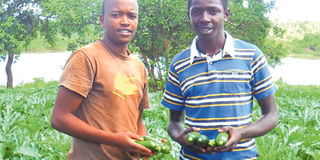Premium
Agronomist notebook: A-Z of farming best courgettes

Cosmas Katinda and Eric Maingi on their courgette farm in Runyenjes, Embu County. The crop does well in relatively warm climate, requiring rainfall of about 800mm during the growing period. FILE PHOTO | NMG
What you need to know:
- When using irrigation, drip system is the best preferred as overhead results to water sprinkling on the leaves, increasing chances of fungal diseases in particular.
- Early land preparation also allows the weeds to decompose, thus improving the soil structure and increasing organic matter, leading to high soil nutrients.
- Once the crop has started fruiting, mulching should be done to prevent the direct contact of the first fruits with the soil, which causes fruit rot.
- Courgettes are affected by pests such as aphids and cutworms which feed on the young tender stems. Adult fruit flies also pierce on the fruits and lay eggs in them.
One of the crops that offer higher returns in the market is courgettes, also known as zucchini.
The crop that belongs to the cucurbit family, with squash, is versatile, tender and easy to cook, and has a niche market in the country.
The crop does well in relatively warm climate, requiring rainfall of about 800mm during the growing period. Nakuru, Kiambu, Nyeri and Uasin Gishu are some of the places where courgettes thrive.
The vegetable fruits have antioxidants and anti-inflammatory compounds and contain little calories. They also have fibre and higher water content that makes it easier to burn the fat contents.
Some of the hybrid varieties grown in Kenya depending on the ecological zones are Simba F1 and Ambassador F1.
Under irrigation, the crop can be grown throughout the year as long as the soils are well-drained and fertile with a pH of about 6.5-7.5.
When using irrigation, drip system is the best preferred as overhead results to water sprinkling on the leaves, increasing chances of fungal diseases in particular.
Courgettes can be grown both in the open field or in the greenhouse, with the latter offering the best results as the controlled environment results into too fewer disease infestations.
One can establish the crop through direct seeding in the bed or plant the seeds in the nursery bed and later to transplant after two or three weeks. Direct seeding, however, is preferred since the seeds are large.
Before planting, the land should be prepared to a fine tilth, best done during the dry season to kill weeds and expose the micro-organisms to the predators.
Early land preparation also allows the weeds to decompose, thus improving the soil structure and increasing organic matter, leading to high soil nutrients.
The crop should be planted at a spacing of 50 by 50 cm to avoid overcrowding due to its growth habits.
In most cases, seeds germinate five to seven days after sowing. Before planting, it’s always best to conduct a soil test to know the specific crop nutrients needed depending on a particular soil.
REDUCED PRODUCTION
To encourage roots development, phosphorous is used during planting, and top dressing is done using nitrogenous fertilisers such as CAN at week three or four.
Weeding should be regularly done to reduce competition of nutrients, lights and space to curb pests and diseases.
Once the crop has started fruiting, mulching should be done to prevent the direct contact of the first fruits with the soil, which causes fruit rot.
Courgette matures faster in two to three months and requires minimum field management practices. Once mature (10-15cm in length), it can be harvested two to three times per week for about two months. Delayed harvesting causes the fruits to overgrow and seed.
Crop rotation should also be done with non-cucurbits crop such as legumes and cereals to reduce the incidences of pest and diseases.
Courgettes are affected by pests such as aphids and cutworms which feed on the young tender stems. Adult fruit flies also pierce on the fruits and lay eggs in them. The larval stages feed on the courgettes and cause discoloured patches.
To curb the pests, maintain hygiene on the farm, use traps and chemicals such as Labdacyhalothrin+lufenuron and Emamectin Benzoate+ Indixocarb.
The most common diseases that affect the crop are powdery mildew and the mosaic, which is a viral infection that is mechanically transmitted and easily spread by aphids. This results in reduced production and dark green patches that alternate with yellow ones.
The crop eventually has stunted growth while the fruits develop water-soaked lesions with solid central stocks. One should use certified seeds and in case of infection, the crop should be uprooted and burnt.
Currently, the cucumbers are going at 50 per kilo at the farm gate price. Courgettes can be used in salads or in making stew.





